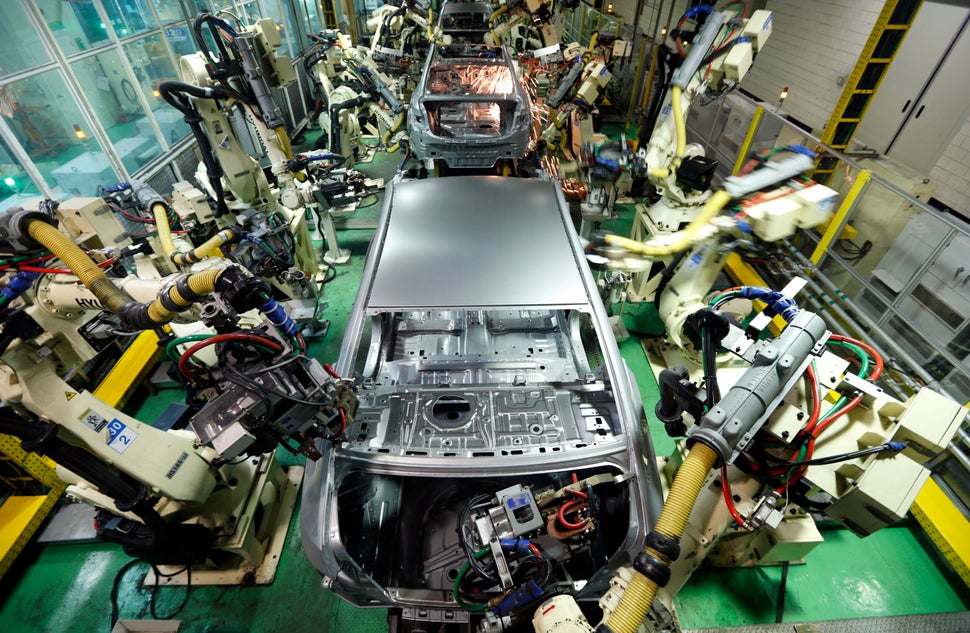South Korean President Moon Jae-in’s ruling party won a landslide victory in last month’s national election as voters turned out in huge numbers in a show of support for a government whose successful containment of the coronavirus pandemic became a model for the world.
His center-left Democratic Party and a satellite party it set up ahead of the vote will now control three-fifths of the 300-seat National Assembly, giving Moon the largest majority of any president in more than three decades.
And as the daily number of new COVID-19 cases dropped to single digits, the results delivered the Moon administration a clear mandate to respond to another deadly global crisis: climate change.
Ahead of the April 15 election, the Democrats vowed to set South Korea ― the world’s seventh-largest source of planet-heating carbon dioxide ― on course to become the first East Asian country to reach net-zero emissions by 2050. The party named its official climate manifesto the Green New Deal, becoming the biggest emitter yet to endorse moving toward the kind of industrial planning and social safety net expansion rarely seen outside of wartime.
South Korea’s proposal includes ending public institutions’ financing of domestic and overseas coal projects, establishing a new program to retrain workers for green jobs, and making large-scale investments in wind and solar energy. The plan also pledges to research and consider a carbon tax.
“The thinking is that maybe we can do better in other things as well, not just COVID-19. There’s a lot of potential for a renewables industry,” said Daul Jang, a Seoul-based senior campaigner at Greenpeace East Asia.
When countries across the world are preparing to scale back climate goals in hopes of boosting economic growth, South Korea’s embrace of new climate measures presents a very different route to economic rebuilding post-pandemic. Environmentalists hope it will propel a wider shift in Asia, where increasing coal use threatens to push global warming past the point of no return.
But skeptics warn that the government’s Green New Deal lacks ambition, especially compared to proposals put forward by progressive rivals in South Korea, and is based on a top-down approach that has little support from labor unions. It also faces the challenge of supercharging a renewables industry dogged by partisan politics and misinformation.
A Long Way To Go
Since 1990, South Korea’s carbon dioxide emissions have grown by nearly 169%, according to the International Energy Agency. Between 2000 and 2014, the country’s increase in climate pollution far outpaced nearly every other member of the Organization for Economic Cooperation and Development, the 37-nation club of major trading economies. Today, South Korea’s total emissions rank behind only China, the United States, India, Russia, Japan and Germany, despite a significantly smaller population.
Electricity and heating account for slightly over half South Korea’s emissions, according to 2018 data collected by the nonprofit Climate Transparency. Industry, including the country’s robust auto manufacturing sector, makes up 25%. Transportation ― the biggest U.S. source of emissions ― produces another 16%. The rest is divided between agriculture, homes and other sources of carbon dioxide.

South Korea’s hunger for electricity has meant consumption levels have swelled by more than 450% over the past three decades, but solar and wind barely make up 2% of power generation. Coal and natural gas produce close to 70% of the country’s electricity, while nuclear reactors generate about a quarter. Hydro dams, oil and biomass ― typically wood-fired generators ― make up the rest.
When Moon took office in May 2017, he vowed to boost renewables while scaling back both fossil fuels and nuclear power, a sector that, despite its low emissions, is dogged by rising costs and fears of radioactive waste.
Seven months after his inauguration, Moon announced a new policy aiming to produce 20% of South Korea’s energy from renewables by 2030. Although a March 2019 report from energy consultancy Wood Mackenzie said South Korea was likely to miss this target, finding the country was on pace to generate 17% of its energy from renewables by 2030.
In April 2019, the Moon administration upped the target for renewables to 35% of the country’s power usage by 2040.

Results last year were mixed.
The government boasted that small-scale projects are turning the province of South Jeolla into a solar hub. In December, officials greenlighted plans to build the world’s largest floating solar farm on a tidal flat on the Yellow Sea.
But stricter regulations on la